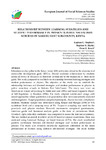| dc.contributor.author | Stephen, Kaptum C | |
| dc.contributor.author | Mailu, Stephen N | |
| dc.contributor.author | Koech, Peter K | |
| dc.date.accessioned | 2019-09-04T08:31:26Z | |
| dc.date.available | 2019-09-04T08:31:26Z | |
| dc.date.issued | 2018 | |
| dc.identifier.issn | 2501-8590 | |
| dc.identifier.uri | http://ir.mksu.ac.ke/handle/123456780/4775 | |
| dc.description.abstract | Education is a key pillar in the Kenya vision 2030 and is also critical to the attainment of sustainable development goals (SDG’s). Dismal academic achievement by students across all levels of education is therefore detrimental to the realization of these noble goals. The study purposed to establish the relationship between learning strategies and student performance in physics. The objective of the study was to establish the relationship between self-directed strategies and student performance in physics in public secondary schools in Nakuru East Sub-County. The study was based on Structuralist Theory of Learning by Steffe and Gale (1995) and Social Cognitive Theory of Self-Regulation by Bandura (1986). The study adopted correlational design with mixed approaches where qualitative and quantitative data were concurrently analyzed and triangulated. Target population comprised principals, physics teachers and physics students. Students’ sample was determined using Krejcie and Morgan (1990) at 95% confidence level and a sampling error of 5%. Purposive sampling was used for the principals and physics teachers. Research instruments comprised questionnaire, interview guide and document analysis guide in the form of performance blank. Cronbach alpha reliability coefficient was computed to assess the internal consistency. The test yielded an overall reliability of r=0.85 based on standardized items. Data was analyzed using Statistical Package for Social Sciences (SPSS). The study established positive correlations between self-directed strategies and student performance in physics. The study also revealed statistically significant differences in the mean performance of learners using different self-directed strategies. The study further
established that self-directed strategies jointly accounted for 77.6% of variance in student performance in physics (R2 = 0. 776). The study recommended that students effectively apply self-directed strategies in their learning so as to optimize their academic achievement. Teachers and schools administration should also create learning environments that encourage the development of self-regulatory skills among learners. | en_US |
| dc.language.iso | en_US | en_US |
| dc.publisher | Open Access Publishing Group | en_US |
| dc.subject | Cognitive strategies | en_US |
| dc.subject | Metacognitive strategies | en_US |
| dc.subject | Resource-regulation strategies | en_US |
| dc.subject | Academic performance | en_US |
| dc.title | Relationship Between Learning Strategies And Student Performance In Physics In Public Secondary Schools In Nakuru East Sub-County, Kenya | en_US |
| dc.type | Article | en_US |

